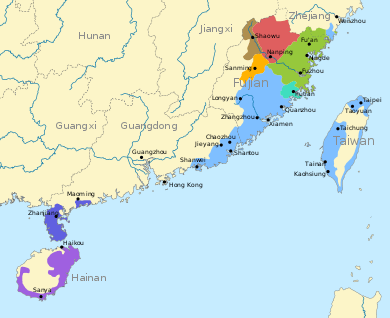Eastern Min
| Eastern Min | |
|---|---|
| Min Dong | |
| Bàng-uâ/平話 | |
| Pronunciation |
"Bàng-uâ" in different dialects [paŋ˨˩ŋuɑ˨˦˨] (Fuzhou) [paŋ˥ŋuɑ˦˨] (Fuqing) [paŋ˥˦˦ŋua˧˨˦] (Gutian) [paŋ˧˩ŋuɑ˩˧˩] (Matsu) [paŋ˨ɰo˧˧˨] (Ningde) [paŋ˨ɰo˨˧] (Fu'an) [paŋ˨ŋua˨˩˨] (Xiapu) [paŋ˨˩ŋua˨˩˧] (Zherong) |
| Native to | Southern China, Taiwan, Vietnam, United States (chiefly New York City) |
| Region | Eastern Fujian (Fuzhou and Ningde), Matsu; parts of Taishun and Cangnan, Wenzhou, Zhejiang |
Native speakers | 9.5 million (2007)[1] |
|
Sino-Tibetan
| |
| Official status | |
Official language in | none |
Recognised minority language in |
one of the statutory languages for public transport announcements in the Matsu Islands, Republic of China[2] |
| Language codes | |
| ISO 639-3 |
cdo |
| Glottolog |
mind1253[3] |
|
Eastern Min | |
Eastern Min, or Min Dong (simplified Chinese: 闽东语; traditional Chinese: 閩東語; pinyin: Mǐndōngyǔ; Foochow Romanized: Mìng-dĕ̤ng-ngṳ̄), is a branch of the Min group of varieties of Chinese. The prestige form and most-cited representative form is the Fuzhou dialect, the speech of the capital and largest city of Fujian.[4]
Geographic distribution
China and Taiwan
Eastern Min varieties are mainly spoken in the eastern part of Fujian Province in People's Republic of China, in and near the cities of Fuzhou and Ningde. They are also widely encountered as the mother tongue on the Matsu Islands, Republic of China. Additionally, the inhabitants of Taishun and Cangnan to the north of Fujian in Zhejiang also speak Eastern Min varieties. Eastern Min generally coexists with the official standard Chinese in all these areas.
America
As the coastal area of Fujian has been the historical homeland of a large worldwide diaspora of overseas Chinese, varieties of Eastern Min can also be found across the world, especially in their respective Chinatowns. Cities with high concentrations of such immigrants include New York City,[5] especially Little Fuzhou, Manhattan; Sunset Park, Brooklyn; and Flushing, Queens.
Europe
They are also found in various Chinatown communities in Europe, including London, Paris, and Prato in Italy.[6]
East Asia
Chinese communities within Ikebukuro, Tokyo, Japan[7] as well as Sibu, Sarawak, Malaysia have significant populations of Eastern Min speakers. Fuzhou communities can also be found in Sitiawan, Perak and Yong Peng, Johor in West Malaysia.
Classification
Branches and influences
The Eastern Min group is conventionally divided into three branches:[8]
- Houguan dialect subgroup (侯官片), including the Fuzhou dialect, Fuqing dialect, Lianjiang dialect and the dialect of the Matsu Islands.
- Funing dialect subgroup (福寧片), including the Ningde dialect and the Fu'an dialect.
- Manjiang dialect (蠻講), spoken in parts of Taishun and Cangnan, Wenzhou, Zhejiang.
Besides these three branches, some dialect islands in the southern Chinese province of Guangdong were classified as Eastern Min.[9][10] Zhongshan Min is a group of Min varieties spoken in the Zhongshan county of Guangdong. According to Nicholas Bodman, only the Longdu dialect and Nanlang dialect belong to the Eastern Min group, while the Sanxiang dialect belongs to Southern Min.[11][12]
References
- ↑ Mikael Parkvall, "Världens 100 största språk 2007" (The World's 100 Largest Languages in 2007), in Nationalencyklopedin
- ↑ 大眾運輸工具播音語言平等保障法
- ↑ Hammarström, Harald; Forkel, Robert; Haspelmath, Martin; Bank, Sebastian, eds. (2016). "Min Dong Chinese". Glottolog 2.7. Jena: Max Planck Institute for the Science of Human History.
- ↑ 李如龙 Li Rulong (1994). 福州方言词典 Fuzhou Fangyan Cidian (Rev. 1st ed.). Fuzhou: 福建人民出版社 Fujian Renmin Chubanshe. p. 1. ISBN 7211023546.
- ↑ Guest, Kenneth J. (2003). God in Chinatown: Religion and Survival in New York's Evolving Immigrant Community ([Online-Ausg.]. ed.). New York: New York University Press. p. 48. ISBN 0814731546.
- ↑ Pieke, Frank. "Research Briefing 4: Transnational Communities" (PDF). Transnational Communities Programme, Institute of Social and Cultural Anthropology, Oxford. Retrieved 2 March 2015.
- ↑ Wong, ed. by Bernard P.; Chee-Beng, Tan (2013). Chinatowns around the world gilded ghetto, ethnopolis, and cultural diaspora. Leiden [etc.]: Brill. p. 251. ISBN 9004255907.
- ↑ Kurpaska, Maria (2010). Chinese language(s) : a look through the prism of the great dictionary of modern Chinese dialects ([Online-Ausg.]. ed.). Berlin: De Gruyter Mouton. p. 71. ISBN 9783110219142.
- ↑ Bodman, Nicholas C. (1984). "The Namlong Dialect, a Northern Min Outlier in Zhongshan Xian and the Influence of Cantonese on its Lexicon and Phonology". Tsing Hua Journal of Chinese Studies. 14 (1): 1–19.
- ↑ Bodman, Nicholas C. (1985). "The Reflexes of Initial Nasals in Proto-Southern Min-Hingua". In Acson, Veneeta; Leed, Richard L. For Gordon H. Fairbanks. Oceanic Linguistics Special Publications. 20. University of Hawaii Press. pp. 2–20. ISBN 978-0-8248-0992-8. JSTOR 20006706.
- ↑ Bodman, Nicholas C. (1984). "The Namlong Dialect, a Northern Min Outlier in Zhongshan Xian and the Influence of Cantonese on its Lexicon and Phonology". Tsing Hua Journal of Chinese Studies. 14 (1): 1–19.
- ↑ Bodman, Nicholas C. (1985). "The Reflexes of Initial Nasals in Proto-Southern Min-Hingua". In Acson, Veneeta; Leed, Richard L. For Gordon H. Fairbanks. Oceanic Linguistics Special Publications. 20. University of Hawaii Press. pp. 2–20. ISBN 978-0-8248-0992-8. JSTOR 20006706.
Further reading
| Min Dong Chinese edition of Wikipedia, the free encyclopedia |
| Wikivoyage has a travel guide for Mindong phrasebook. |
- Norman, Jerry (1977–1978). "A preliminary report on the dialects of Mintung". Monumenta Serica. 33: 326–348. JSTOR 40726246.
- Yan, Margaret Mian (2006). Introduction to Chinese Dialectology. LINCOM Europa. ISBN 978-3-89586-629-6.
- Akitani Hiroyuki; Chen Zeping [秋谷裕幸; 陈泽平]. 2012. The Gutian dialect of Min Dong District [闽东区古田方言研究]. Fuzhou: Fujian People's Press [福建人民出版社]. ISBN 9787211064830


